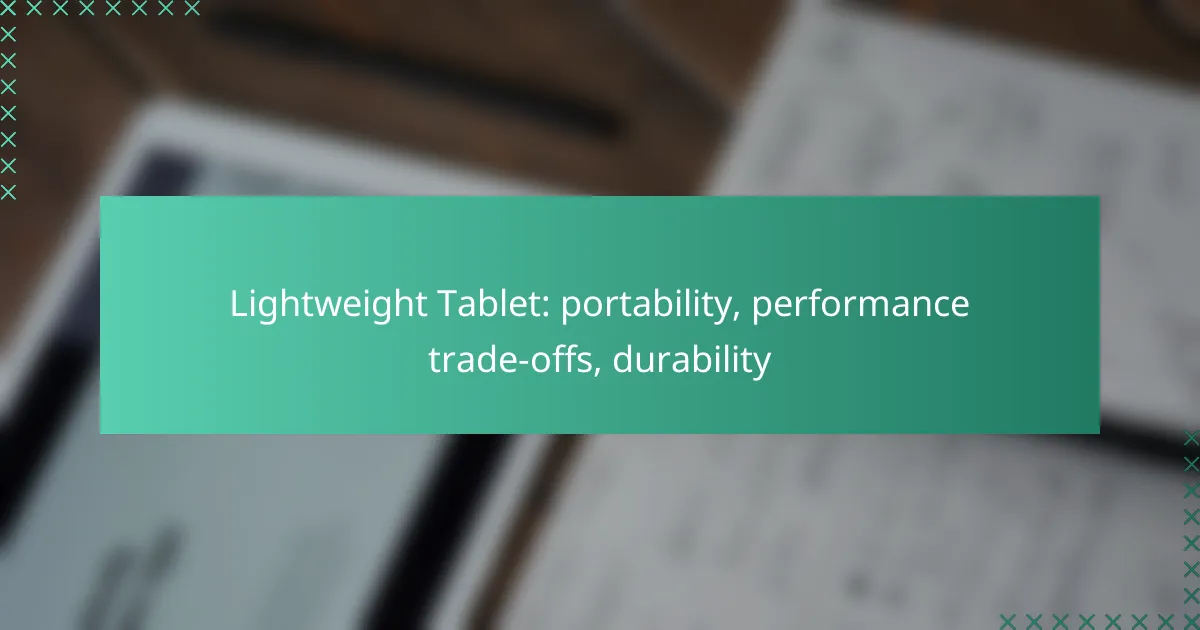Lightweight tablets are designed for optimal portability, making them perfect for users who need a device that is easy to carry without compromising too much on performance. While they excel in quick boot times and convenience, potential buyers should consider the trade-offs in processing power and multitasking capabilities. Additionally, many models incorporate durability features to withstand everyday challenges, ensuring they remain functional even in demanding environments.
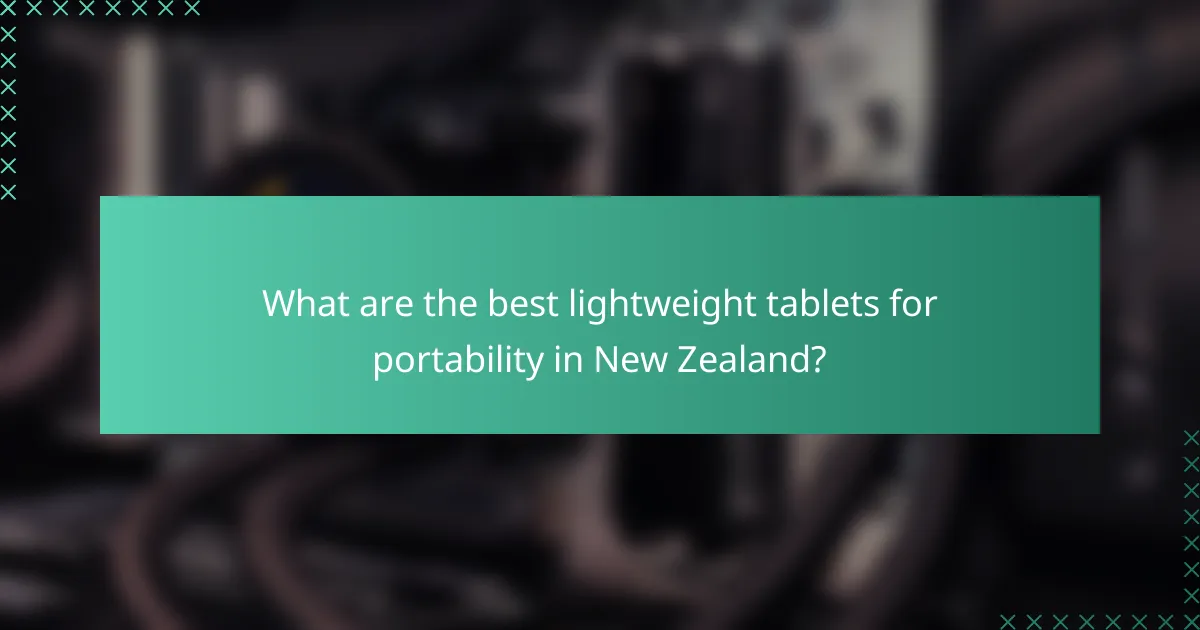
What are the best lightweight tablets for portability in New Zealand?
The best lightweight tablets for portability in New Zealand combine slim designs with robust performance, making them ideal for on-the-go use. Key options include the Apple iPad Air, Samsung Galaxy Tab S7, and Microsoft Surface Go 2, each offering unique features suited for different user needs.
Apple iPad Air
The Apple iPad Air is renowned for its sleek design and powerful performance, weighing around 460 grams. Its A14 Bionic chip ensures smooth multitasking and app performance, making it suitable for both casual browsing and demanding tasks.
With a battery life of up to 10 hours, the iPad Air is perfect for long journeys or extended use without needing a recharge. Additionally, its compatibility with the Apple Pencil and Magic Keyboard enhances its usability for creative professionals and students alike.
Samsung Galaxy Tab S7
The Samsung Galaxy Tab S7 offers a balance of portability and performance, weighing approximately 490 grams. It features a vibrant 11-inch display and a Snapdragon 865+ processor, making it excellent for media consumption and productivity tasks.
Its battery can last up to 15 hours, providing ample time for work or entertainment. The included S Pen adds functionality for note-taking and drawing, appealing to users who value versatility in their devices.
Microsoft Surface Go 2
The Microsoft Surface Go 2 is a compact tablet that weighs about 522 grams, designed for those who need a lightweight device with Windows functionality. It features a 10.5-inch touchscreen and runs full Windows 10, allowing users to access familiar software and applications.
With a battery life of around 10 hours, it is suitable for daily tasks and light gaming. The Surface Go 2’s optional Type Cover transforms it into a laptop-like experience, making it a practical choice for students and professionals who require portability without sacrificing performance.
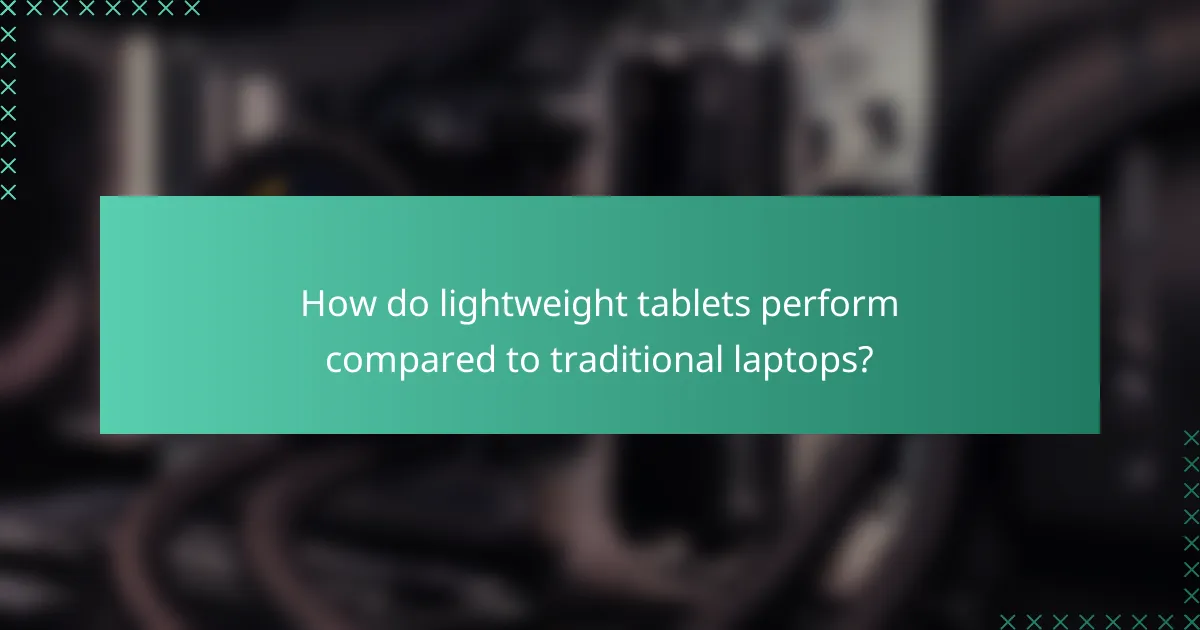
How do lightweight tablets perform compared to traditional laptops?
Lightweight tablets generally offer quicker boot times and enhanced portability compared to traditional laptops, but they often sacrifice processing power and multitasking capabilities. Users should weigh these performance trade-offs based on their specific needs, such as casual browsing versus demanding applications.
Faster boot times
Lightweight tablets typically boot up in just a few seconds, making them ideal for users who need quick access to their devices. In contrast, traditional laptops may take significantly longer, often ranging from 20 seconds to over a minute, depending on the operating system and hardware.
This rapid startup allows users to jump straight into tasks like checking emails or browsing the web without delay. For those who prioritize convenience and speed, lightweight tablets are a compelling choice.
Lower processing power
While lightweight tablets excel in portability and quick access, they usually feature lower processing power compared to traditional laptops. This means they may struggle with resource-intensive applications such as video editing or gaming, which require more robust hardware.
For everyday tasks like web browsing, document editing, and streaming, lightweight tablets perform adequately. However, users needing high-performance capabilities should consider a traditional laptop, especially if they work with demanding software.

What are the durability features of lightweight tablets?
Lightweight tablets often incorporate various durability features to withstand everyday wear and tear. Key aspects include water resistance and drop test performance, which help users gauge how well a device can handle accidental spills and falls.
Water resistance ratings
Water resistance ratings indicate how well a tablet can resist moisture. These ratings are often defined by the Ingress Protection (IP) standard, with common ratings for tablets ranging from IP54 to IP68. An IP68 rating means the device can withstand submersion in water beyond 1 meter for extended periods, making it suitable for use in wet environments.
When choosing a tablet, consider your usage scenarios. If you frequently use your device outdoors or in kitchens, look for higher IP ratings to ensure better protection against spills and splashes. Remember that water resistance can diminish over time, so handle your device carefully.
Drop test results
Drop test results measure how well a tablet can endure falls from various heights. Many manufacturers conduct tests from around 1 to 1.5 meters to simulate real-world accidents. Tablets with rugged designs often feature reinforced corners and shock-absorbing materials to enhance durability.
When selecting a lightweight tablet, check for drop test certifications or user reviews that mention durability in everyday use. Devices designed for business or outdoor use typically have better drop resistance, making them a wise choice if you need a robust tablet.
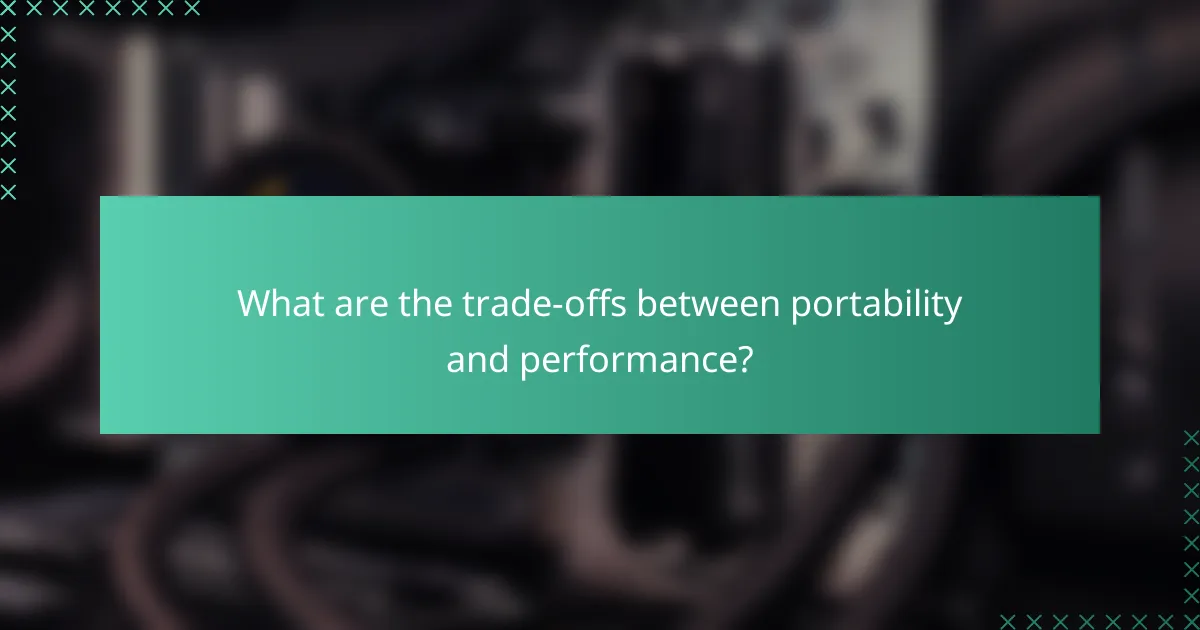
What are the trade-offs between portability and performance?
The trade-offs between portability and performance in lightweight tablets involve balancing ease of transport with the device’s capabilities. Generally, more portable tablets tend to have lower processing power, while those with higher performance may sacrifice some portability due to size and weight.
Battery life vs. processing speed
Battery life and processing speed are closely linked in lightweight tablets. Devices that prioritize longer battery life often use less powerful processors, which can limit performance during demanding tasks. Conversely, tablets equipped with high-speed processors may consume more power, resulting in shorter battery life.
For example, a tablet with a battery life of around 10-15 hours may feature a mid-range processor, suitable for everyday tasks. In contrast, a tablet with a high-performance chip might only last 6-8 hours under heavy use, making it less ideal for users needing extended portability.
Screen size vs. weight
Screen size and weight are significant factors in the portability of lightweight tablets. Larger screens enhance the viewing experience but can increase the overall weight of the device, making it less convenient to carry. A typical lightweight tablet may range from 7 to 12 inches in screen size, with weights varying accordingly.
For instance, a 10-inch tablet might weigh around 1-1.5 pounds, striking a balance between usability and portability. However, a 12-inch tablet could weigh closer to 2 pounds, which may be cumbersome for users who prioritize lightweight options for travel.
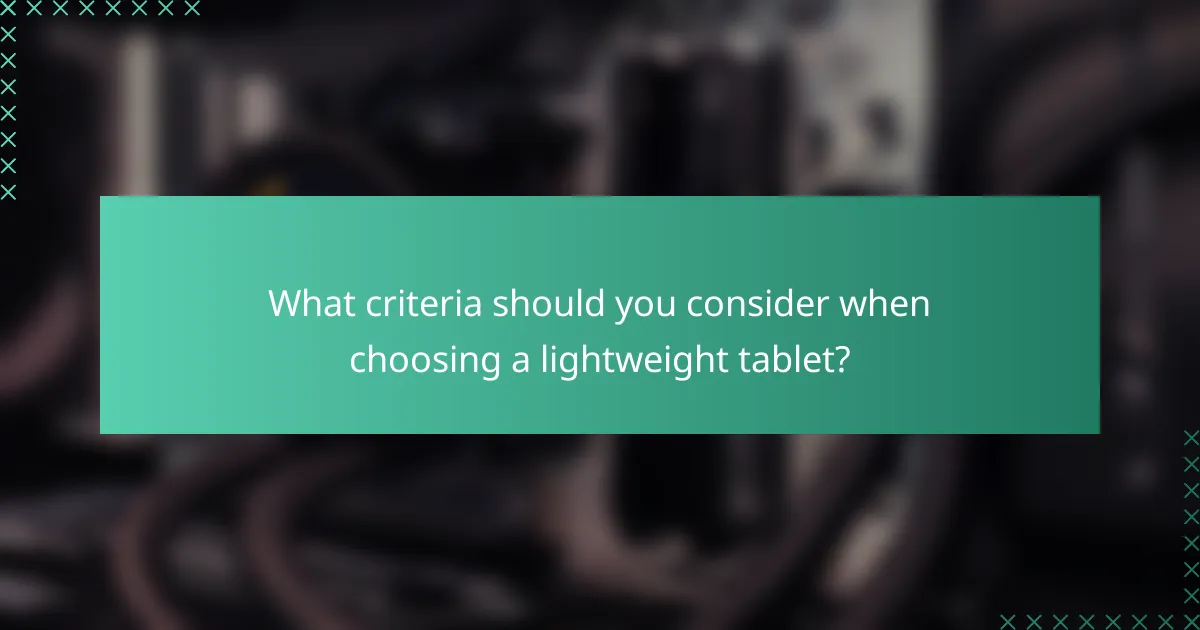
What criteria should you consider when choosing a lightweight tablet?
When selecting a lightweight tablet, prioritize portability, performance, and durability. Assess how these factors align with your specific needs, such as usage scenarios and budget constraints.
Operating system compatibility
Operating system compatibility is crucial as it determines the apps and features available on your tablet. The most common systems are Android, iOS, and Windows, each offering unique advantages. For instance, iOS is known for its user-friendly interface and robust app ecosystem, while Android provides more customization options.
Consider what software you rely on for work or leisure. If you need specific applications, verify their availability on the tablet’s operating system. Additionally, think about how frequently the OS receives updates, as this affects security and functionality over time.
Storage options
Storage options vary significantly among lightweight tablets, typically ranging from 32GB to 512GB or more. Assess your storage needs based on how you plan to use the device. If you intend to store large files like videos or games, opt for higher storage capacity or consider models with expandable memory via microSD cards.
Keep in mind that cloud storage can supplement physical storage, allowing you to access files without taking up space on the device. However, ensure you have a reliable internet connection for seamless access to your cloud services.
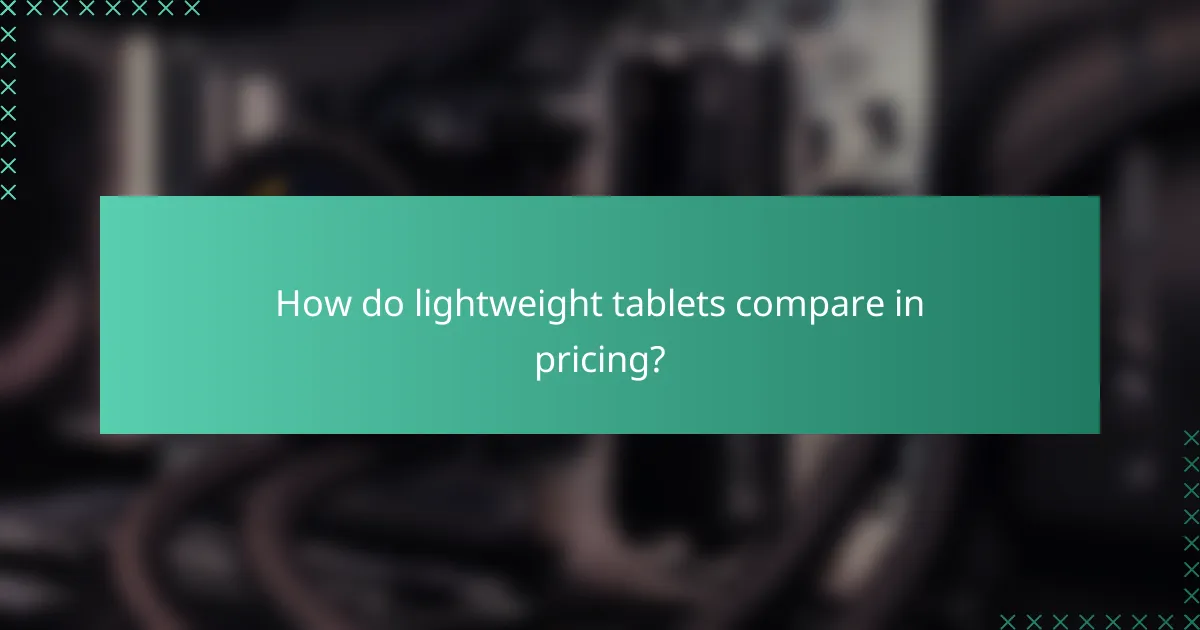
How do lightweight tablets compare in pricing?
Lightweight tablets generally range in price from budget-friendly options to high-end models, reflecting their features and performance capabilities. Understanding these price segments helps consumers choose a device that fits their needs and budget.
Budget options under NZD 500
Budget lightweight tablets typically offer essential features suitable for basic tasks like browsing, reading, and streaming. These devices often have lower processing power and storage, which may limit performance for demanding applications.
Popular models in this price range include brands like Samsung and Lenovo, which provide decent displays and battery life. When considering a budget tablet, look for at least 3GB of RAM and a minimum of 32GB of storage to ensure a satisfactory experience.
Premium models over NZD 1000
Premium lightweight tablets are designed for users who require high performance, superior displays, and advanced features. These models often include powerful processors, high-resolution screens, and enhanced build quality, making them suitable for professional use and creative tasks.
Brands like Apple and Microsoft dominate this segment, with products that feature excellent app ecosystems and accessories. Investing in a premium tablet often means better longevity and support, so consider your long-term needs when making a decision.
